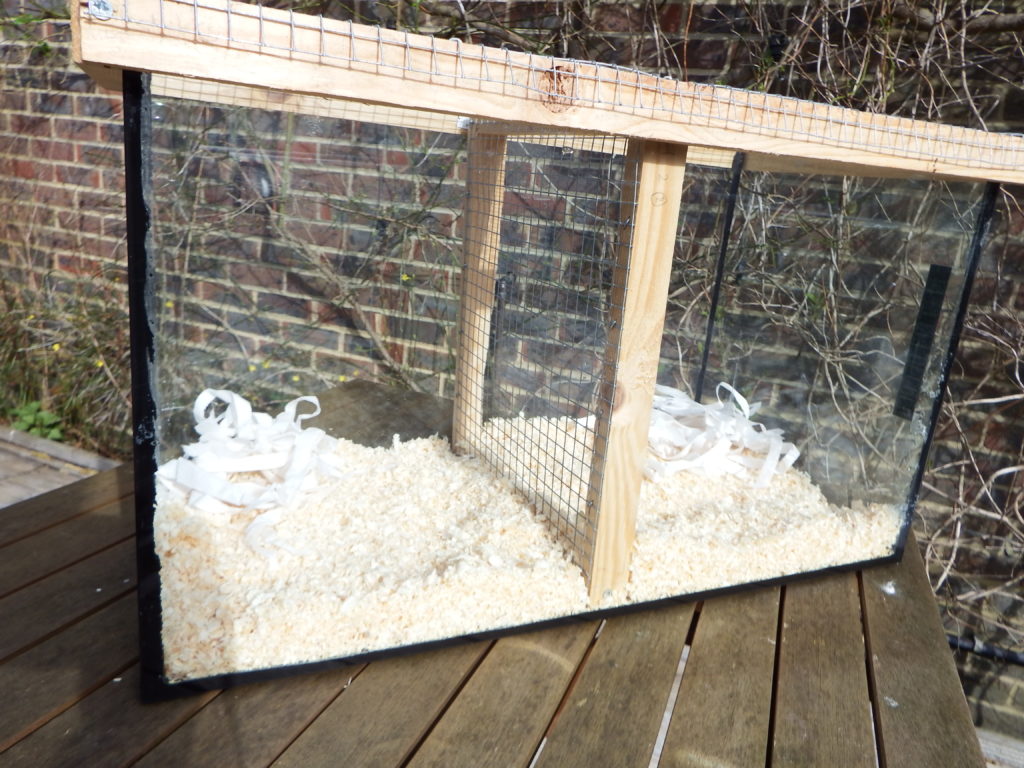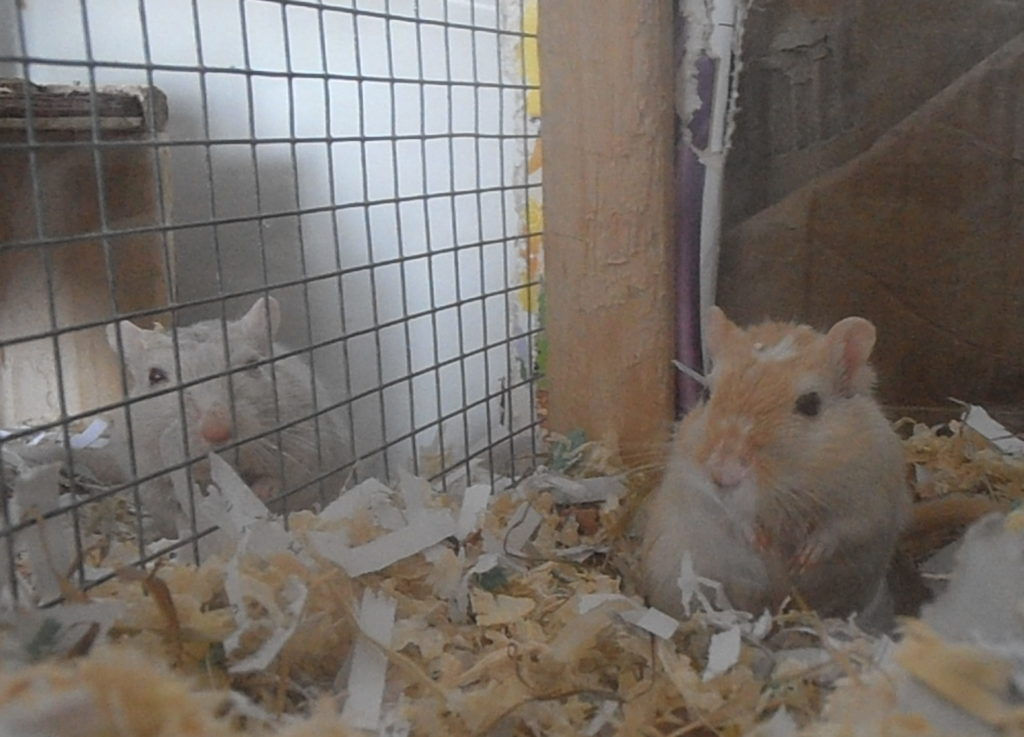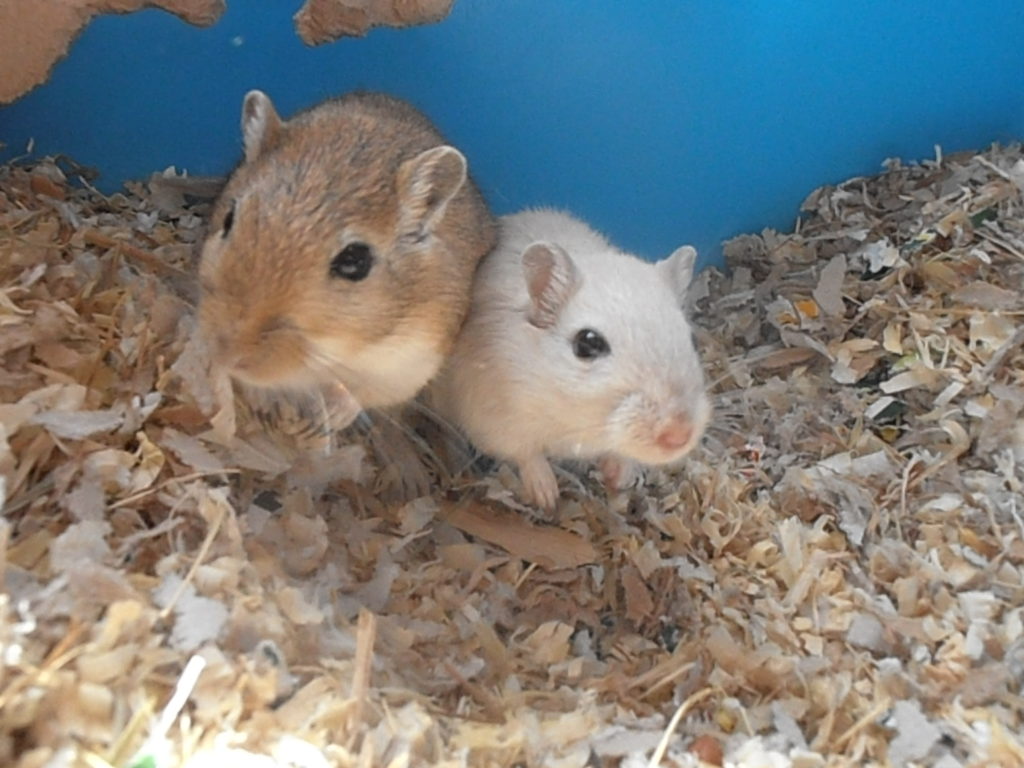Split tanks are a really effective – and safe – way of bonding together two unknown adult gerbils to form a new clan.
The basic premise is to put two separate gerbils in a small tank with a secure but removable divide in the middle to ‘split’ the tank into two sides.
You keep swapping them between the two sides for several days or weeks until they get used to each other’s company and the whole tank smells equally of both of them – then (when safe to do so) – you remove the divide between them.
Split Tank are safe, small, easy to build, cheap, effective and reusable items – and are invaluable to a gerbil owner.
However, they are best used in a specific and prescribed way to not only get you the best results – but also to prevent injury to your gerbils.

So, please, when doing a split tank introduction, stick as closely to the plan as possible to reap the rewards.
An Introduction to a Split Tank Introduction:
Assuming you have your two adult gerbils in mind already; you will be about a fair amount during the next 3 weeks; and you have your empty split tank to hand – we shall begin.
Step 1 – Set Up the Split Tank: Add only a thin layer of bedding, a small amount of nesting material or hay and then put a water bottle on each side. Done.
The whole idea of a Split Tank is to create a close bond between your two gerbils – and this is best done without any distractions. The lack of anything else to do in a Split Tank encourages your gerbils to interact with each other and without too many creature comforts they will interact more often.
The gerbils should never be on the same side at the same time, or meet each other outside of this tank.
Step 2 – Add the Gerbils: Put one gerbil on each side of the divide and throw in a handful of food on each side – close to the divide for best measure.
Although the Split Tank has two sides – neither side should be attributed to either gerbil. The gerbils will keep being swapped from side to side so that there is a blur between them and the gerbils will start to assume that both sides are theirs.
This is the key to the Split Tank Introduction.
Step 3 – Leave to Simmer: Ideally you want the gerbils to spend several hours on this first side – maybe longer.
They need to have had enough time there to have had a good look around – met the new gerbil through the divide and perhaps had a good meal and a snooze – possibly even having started to build a nest.
It is best to plan your swaps so that you have 3 every day – so first thing, again in the afternoon and then the final one before you go to bed yourself.
It ideally needs to be an uneven amount so they each have to sleep on the other ones side overnight every night – as sleeping in each others nests is a really positive sign that they might like each other.
3 times isn’t always possible for everyone – so 1 swap a day is fine on days you are busy as it gives you the same result. If you do 2 swaps one day and then forget the last one – it doesn’t matter in the bigger picture.
Less swaps per day just means the scents are mixing slower and the results could take longer.

Step 4 – Don’t change anything: Don’t clean out the bedding at all during the Split Tank process on either side.
Unless there is an accident with the water bottle or something – leave all the existing bedding right where it is throughout the whole Split.
The point of the Split is to mix up their scents so they both think they live on both sides – and the bedding is all they have to tell them that.
You can add more a little more bedding and nest material and the odd toilet roll to chew up if you want, but try to keep things unchanged for as long as you can.
You will be introducing them to each other for the first time in this dirty bedding – so if you have to change it all for whatever reason, you need to add more time back onto the whole process to allow this smell to build up again.
For the same reason – don’t let them play outside of the Split Tank. You are trying to focus their attention on this tank, this bedding and this gerbil – don’t keep taking them away from that and introducing them to something else.
No play time during a split is the best policy.
Step 5 – Keep Going: Keep swapping sides day after day until you start to see some ‘good signs’ between the two gerbils.
Good signs include sniffing and grooming through the bars; not scent-marking so vigorously when you swap sides (unless it is a male and you are splitting a male and female together); and not destroying each other’s nests every time you swap – ideally they want to be sleeping in them as they find them.
Once you have seen a few days of ‘good signs’ you may want to consider removing the divide.
You always do the Introduction in the Split Tank itself – you never take the gerbils out and put them in a new space. That defeats the whole point of the Split.
In a new space – they have no ownership, they are a little bit scared because of that and they are easily spooked in the open. Leave them in their current home and just remove the divide.
You need to plan this day carefully so that you have everything you need to hand as well as (ideally) an entire day at home with the gerbils after you have removed it. You need to watch them like a hawk.
You can’t just take it out and cross your fingers – there could be a serious fight if you are unlucky.
Step 6 – The First Meeting: Not every introduction works out first time – so you have to be on your toes. If it doesn’t work out straight away – pop the divide back in and continue swapping sides for another 3 or more days.
Scuffling and chasing can happen – just as long as you were there to protect them from harm they will live to have another go.
Even if they went into a ball fight – it doesn’t mean it will never work – it just means they need a bit longer in the Split Tank. If they just had a scuffle – think forward to the next day you are at home for the whole evening – and plan to try again then.
If they actually had a decent fight that you had to split up with a pot or stick (hopefully not your own hand) then perhaps assume they will need at least a week before you try again.
If they had been in the Split already for nearly 3 weeks, then perhaps take this opportunity to clean out some of the bedding and replace with fresh – they will have time to scent mark all over it again in the following week anyway.
Step 7: Finally – they are Friends: When you get to the Introduction where they don’t scuffle or fight – congratulations are in order. You got it right.
When it all works out you will see them eating together – and most importantly sleeping together – in the hours after you remove the divide.
Phew.

There are still a few things that can affect this harmony at this or at any of the other steps – so do read more around the subject before you start your Split Tank Introduction – especially if it is your first one.
Other articles that may be of interest include Split Tank Introductions; Part 1 – Planning The Introduction and Split Tank Introductions; Top Tips.
Also if you need it: How To Make A Split Tank Divide.
Hello,
A couple people have told me that if a split tank intro doesn’t work out between my adult male and two 7-week old baby males, that they won’t do well as a permanent split cage. Is this true? And if so, why not?
Our adult male lost his bro a few weeks ago and we thought that since he was sad and lonely, that intro-ing him to the babies in a split cage would be a good solution. But it’s our first time doing a split cage and even though we researched a lot beforehand, we found a bunch of conflicting info about the minutiae. It’s only now, 4 days in, that we found the first mention of info that giving playpen time is not good. We also found that we need an overhanging extension to our 2 mesh barriers so they don’t climb over.
We blundered into the perfect storm of trying to take the babies out for a playpen session, on Day 4, when they’d finally settled down to no dominance-wrestling between the babies, minimal scent marking on swapping sides, almost no interest in the adult gerbil on the other side, and being willing to most of the time to sleep in whatever existing nest there was right next to the barriers after swapping (instead of destroying it and reconstructing).
That’s when our adult quickly clambered up the barrier vertically and crash-landed from a 13 inch drop right into the baby side, freaking out the babies and the one that had been more dominant of the two got into a ball fight with the adult. (I didn’t have my gloves on at the moment but I got them separated. Got a lot of bandaids on my hands now. )
The baby and adult each have a small bite on them (taking them to the vet for a checkup, even though it doesn’t look too bad and seems to be already healing) and the breeder I got the adult from a couple years ago, said since that was only Day 4, and they’d been making good improvement beforehand, and it was a freak accident, that it should be ok to separate them for a day or two and then start from the very beginning for split caging. (She also recommended vanilla however.)
A number of folks though are saying abandon all hope, it’ll never happen, give up and just permanently split cage them. That’s when a couple people chimed in that one can’t permanently split-cage one adult with two babies, but had no specific reasons why.
So I found your site and learned WHY playpen time is not good during splitcaging and WHY vanilla is not good. (Thank you so much for providing that info.)
Now I am hoping you might have the answer for whether a 2-babies/1-adult permanent split cage is do-able if my second try at getting these boys together doesn’t work out, and why it might not be do-able.
Also, I’ve noticed that most of the guides for split-caging mention that at the first full no-barriers intro, if they ball-fight, to separate them and try again after a week. But presumably that ball-fight would have included some biting. But then there’s all these doom-sayers saying that bites from an intro-too-soon means they can never work out and one should not even try again.
It’s conflicting info, so I was hoping you might be able to shed some light on that as well. Especially as this wasn’t a full course of split-caging, just an accident on Day 4 when things were otherwise going well for the most part.
Thank you very much for any insight or advice you might have.
Thank you for visiting our information here – and I love the way – like me – you question things for the ‘why’ rather than just accepting everything people say to you.
So firstly, the whole two-to-one permanenet split. The reason these don’t often work out is due to the two side of the tank. Gerbils can find an easy balance with two gerbils: one beats the other one up enough that it just agrees with everything the other one says, or one is just happy to be the silent partner and puts up with being told what to do all the time. This is why sibling (or long term together-from pup) pairs are usually the most stable. They both know their place already and so when they grow up and their hormones kick in all is still well. They don’t need to show off to anyone or make new friends/fight new enemies.
So, when you have a pair of pups and a third gerbil (your old guy) if they aren’t put in young enough he won’t become their boss in time (before their hormones kick in) and so over time, they will start to want to be in charge themselves (if they are the dominant type of course). Just like people in a group – if you have you and your best friend together and you meet a great mentor/teacher while you are young – you will most likely never challenge them about anything – they are the boss and you respect them. But if you are friends at college and another person joins your group as an equal, the bond you had with your first friend will most likely be different when in the presence of your new friend – it has to be as you are all different.
So – to cut a long story short – if your two new pups start to mature with a different gerbil’s scent wafting in all the time and where they can touch this gerbil even – you are affecting the existing pair’s bond. And depending on the balance of friendship between your original pair, this might cause them to act differently. If your dominant pup is striving to become a super leader for example, but he can never get rid of the smell of an outsider, he may start to act differently around his one time friend/brother and this could lead to a declan. The single gerbil won’t have anything directly to do with this as it can’t change its status as a single. One is one – he’s his own boss.
Quite often when these trios don’t work out however, you can usually fully split together the least dominant pup to the older guy with no issues as neither of them want to fight as both are more accepting – however of course, you are them still left with a single. This is all because gerbils like to be in control of their domain (which includes the space they live in and the gerbils they live with) so any imbalance here is what can cause a problem – even between gerbils who have lived together for 3 years. If you upset their delicate balance with a new smell, it could be the instant end of their clan.
On to the ball fight query when in the split – it is all to do with a gerbils natural reaction.
If two gerbils meet and one thinks they own the place (for whatever reason but usually because most of it smells like them) they will instantly fight off the other gerbil. It doesn’t mean they don’t like them – it is just the way they would react to something that totally suprises them – just like you would I suppose if you found someone in your house that you didn’t know. You would no doubt be suprised and shout/threaten/chase them away depending on the circumstances.
However afterwards, if you had had time to talk to them in a refreshed and more relaxed state of mind, you may well then find out that they are really nice and you could be their friend. It was just the first intro was wrong (like with gerbils where it happened too soon as we misread the signs as owners, or we didn’t make our split tank divide secure enough (it should be full height and full width and solid). So it wasn’t their mistake – they didn’t hate each other, they were just startled. Therefore setting the split tank up afresh with clean bedding, planning to take a bit longer this time and being a bit more thorough along the way could well restart the intro and have a different end result.
I hope that answers both your main questions (and isn’t too long) but do feel free to chase for any further details if needed.